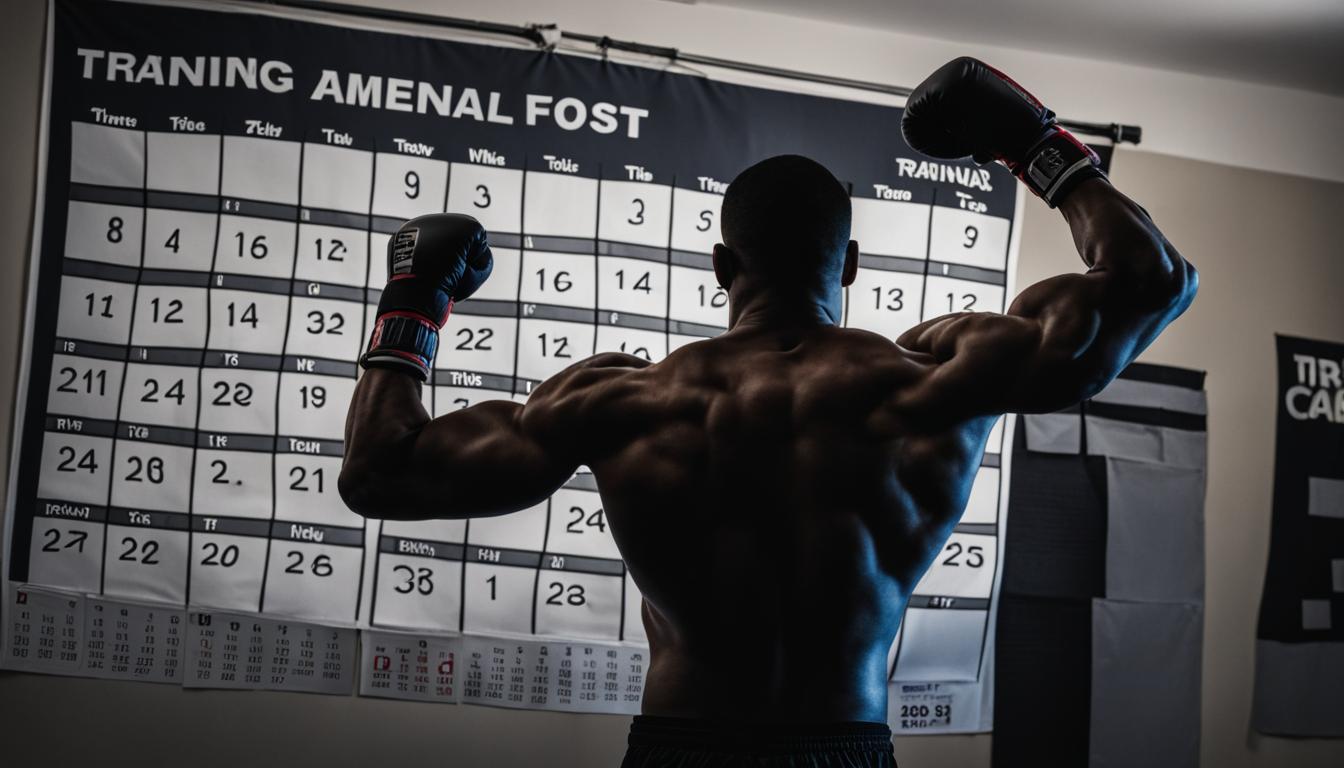Boxing is a challenging sport that requires speed, agility, finesse, power, endurance, and mental toughness. It offers various benefits, such as a great workout and personal growth. To learn boxing, beginners need to start with mastering the basic techniques, including the boxing stance, footwork, and punches. The duration of learning boxing can vary depending on individual goals and dedication to training.
Key Takeaways:
- Boxing is a physically demanding sport that offers multiple benefits.
- Beginners should focus on mastering the basic techniques, such as the boxing stance, footwork, and punches.
- The duration of learning boxing varies based on individual goals and commitment to training.
- Regular practice and seeking guidance from experienced coaches are crucial for progress.
- Set realistic goals and enjoy the journey of learning and improving in boxing.
The Basic Boxing Technique
The basic boxing technique encompasses three fundamental elements: the boxing stance, footwork, and punches. Mastering these aspects is crucial for any aspiring boxer looking to build a solid foundation in the sport.
The Boxing Stance
The boxing stance is the starting point for every boxer and plays a vital role in maintaining balance, stability, and preparedness for both offensive and defensive maneuvers.
To achieve the proper boxing stance:
- Position the front toe and back heel along the center line, about shoulder-width apart.
- Distribute your weight evenly across both legs to ensure stability.
- Keep your elbows down, close to your body, to protect your ribs.
- Keep your hands up, near your face, to defend against punches.
Adopting the correct boxing stance sets the stage for executing punches effectively and maintaining balance throughout the fight.
Footwork in Boxing
Footwork is of utmost importance in boxing as it enables boxers to move swiftly, evade punches, and generate power.
Two essential footwork maneuvers for beginners to master are the step-drag and pivot:
- The step-drag involves stepping forward or backward with one foot and then dragging the other foot to meet it. This maneuver helps maintain stability while closing the distance or creating space.
- Pivoting involves rotating on the ball of the foot to change directions quickly and create angles. It allows boxers to move around opponents effectively and find openings for punches while maintaining balance.
By honing their footwork skills, boxers can control the pace of the fight, seize opportunities, and maintain a solid defensive position.
Boxing Punches
Boxing punches are the primary offensive weapons a boxer utilizes in the ring. Each punch serves a specific purpose and requires proper technique to be effective.
The basic punches in boxing include:
- The jab: A quick, straight punch thrown with the lead hand. It’s used for offense, defense, and to set up other punches.
- The cross: A powerful straight punch delivered with the rear hand. It’s thrown with a rotational motion and generates significant power.
- The hook: An arcing punch thrown with a bent arm, targeting the opponent’s chin or body from the side. It’s effective at close range.
- The uppercut: A punch thrown upward from a crouched position, aiming for the opponent’s chin. It’s effective in close-quarter situations.
Each punch requires proper weight transfer, arm extension, hip rotation, and coordination to connect with maximum force and accuracy.
Mastering the basic boxing technique, including the boxing stance, footwork, and punches, is crucial for a boxer’s success in the ring. Practice, dedication, and guidance from experienced coaches can help aspiring boxers develop solid fundamentals and excel in this challenging sport.
Benefits and Popularity of Boxing
Boxing is not just a sport; it offers numerous benefits for both physical and mental well-being. The physically demanding nature of boxing provides an excellent workout that improves cardiovascular health, builds strength, and enhances overall fitness. Regular boxing training sessions help to increase agility, develop hand-eye coordination, and sharpen reflexes. These physical benefits make boxing a popular choice for individuals looking to improve their physical condition and enhance their athletic performance.
Moreover, boxing also offers significant mental benefits. The discipline required to learn the sport fosters self-control, builds discipline, and enhances mental toughness. As individuals progress in their boxing skills, they gain a sense of confidence and self-assurance. The mental challenges faced during training and competition help individuals develop resilience and determination, which can be applied to various aspects of life.
It’s no wonder that boxing has gained immense popularity worldwide. The sport has captured the hearts of millions, inspiring both athletes and enthusiasts alike. Famous boxers such as Muhammad Ali, Mike Tyson, and Floyd Mayweather have become household names, demonstrating the global appeal of boxing. Additionally, boxing has also made its mark in popular culture, with numerous movies and documentaries showcasing the sport’s excitement and drama.
Boxing’s popularity extends beyond the elite competitors and reaches fitness enthusiasts who incorporate boxing-style training into their workout routines. The high-intensity workouts, focus on technique, and total body engagement make boxing training a favorite among those seeking an effective and enjoyable way to stay fit. The incorporation of boxing drills and exercises into fitness classes and programs further testifies to the sport’s enduring popularity.
Key Benefits of Boxing:
- Improved cardiovascular health
- Increased strength and overall fitness
- Enhanced agility, hand-eye coordination, and reflexes
- Discipline and mental toughness development
- Boosted self-confidence and self-assurance
Boxing’s benefits and popularity make it a dynamic and captivating sport that continues to attract individuals from all walks of life. Whether it’s for personal improvement, competition, or simply the joy of participation, boxing provides a challenging and rewarding experience both in and out of the ring.
Training for Boxing Skill Development
To develop boxing skills effectively, regular and well-rounded training is crucial. Training sessions should include a combination of various aspects to enhance both physical abilities and technical proficiency.
Here are some key components to include in your boxing training regimen:
- Cardio exercises: Engage in cardiovascular workouts like running, jumping rope, or cycling to improve stamina and endurance.
- Punching bag and speed bag practice: Utilize these training tools to enhance punching power, accuracy, and speed.
- Glove work: Focus on precision and defensive techniques through partner drills and pad work.
- Shadowboxing or sparring: Practice your boxing moves, footwork, and defensive maneuvers either solo or with a partner.
- Strength training: Incorporate strength exercises such as weightlifting, bodyweight exercises, and resistance training to build overall power and muscle strength.
- Stretching: Don’t forget to include flexibility exercises to improve range of motion and prevent injuries.
It’s essential to focus on specific drills targeting boxing skills that need improvement. Here are a few examples:
- Footwork drills: Practice agility and balance through ladder drills, cone drills, or pivoting exercises.
- Punching technique drills: Refine your jab, cross, hook, and uppercut techniques through repetitive and controlled practice.
- Conditioning exercises: Incorporate exercises that mimic the intensity and duration of boxing rounds to improve overall conditioning and endurance.
Working with a knowledgeable coach or trainer is highly recommended as they can provide expert guidance, offer personalized training programs, and valuable feedback to enhance your technique and progress in skill development.
By incorporating these training methods and focusing on continuous improvement, you can enhance your boxing skillset, improve technique, and work towards achieving your boxing goals.
Recommended Training Frequency for Progression
The recommended training frequency for progressing in boxing depends on individual goals and fitness levels. To achieve steady progress, it is important to establish a consistent training routine. Beginners should aim for at least two boxing sessions per week to build a solid foundation of skills and conditioning. Each session should last a minimum of 2 hours to allow sufficient time for warm-up, practice, and cool-down.
To accelerate progress and see noticeable improvements, it is advisable to increase the frequency of training sessions. Ideally, three to five workouts per week are recommended for those looking to make significant advancements in their boxing skills. This increased frequency allows for more practice and repetition, leading to better muscle memory and technique mastery.
However, it is crucial to strike a balance between training intensity and recovery. Overtraining can increase the risk of injuries, hinder progress, and lead to burnout. Rest and recovery days are essential to allow the body to heal, repair muscles, and prevent fatigue. It is important to listen to the body’s signals and adjust the training frequency accordingly.
Remember, boxing training is not solely about quantity but also quality. It is crucial to train with focus, precision, and dedication during each session. Prioritize proper technique, speed, accuracy, and endurance to optimize skill development.
By following a consistent training routine and incorporating adequate rest and recovery, individuals can progress steadily and achieve their desired boxing goals.
| Training Frequency | Duration per Session |
|---|---|
| Beginners | 2 sessions per week |
| Intermediate | 3-4 sessions per week |
| Advanced | 4-5 sessions per week |
Tips for Faster Progression in Boxing
To progress quickly in boxing and improve your skills, consider the following tips:
- Find a Good Coach: A knowledgeable coach can provide valuable guidance, correct your technique, and help you avoid developing bad habits.
- Vary Your Exercises: Incorporate a variety of exercises into your training routine to improve different aspects of boxing. This can include shadowboxing, sparring, and finger exercises.
- Focus on Technique: Emphasize proper technique over pure power. Pay attention to your stance, footwork, punches, and defensive maneuvers to ensure well-rounded skill development.
- Improve Speed and Endurance: Work on drills and exercises that specifically target speed and endurance. This can include speed bag drills, skipping rope, and interval training.
- Develop Precision and Balance: Practice precision and balance through drills that require accurate punches and maintain stability. This can help improve your overall boxing skills.
- Respect Recovery Time: Allow your body sufficient time to recover between training sessions. Rest days are crucial for muscle repair and preventing overtraining.
- Listen to Your Body: Pay attention to any signs of fatigue, pain, or injury. It’s important to listen to your body and adjust your training accordingly to avoid long-term damage.
- Stay Hydrated: Proper hydration is essential for optimal performance and recovery. Drink plenty of water before, during, and after your training sessions.
By incorporating these tips into your boxing training, you can progress faster and improve your skills in the ring.
Conclusion
Learning boxing requires dedication and consistent training. The duration of learning boxing may vary for each individual, depending on their goals and commitment. By following proper technique, training regularly, and seeking guidance from experienced coaches, individuals can progress in their boxing skills and achieve their desired goals.
Whether you’re learning boxing for fitness, self-defense, or aspiring to become a professional boxer, the journey is worthwhile. Boxing offers numerous physical and mental benefits that can transform not only your physique but also your mindset. It improves cardiovascular health, strength, agility, and hand-eye coordination. Moreover, it builds discipline, self-confidence, and mental toughness.
While there is no fixed timeline for learning boxing, consistency is key. Engaging in regular boxing sessions, at least two hours per week, can help you see progress. However, it’s important to listen to your body and avoid overtraining to avoid injuries. Remember to incorporate rest and recovery days for proper muscle repair and overall well-being.


